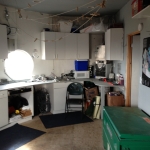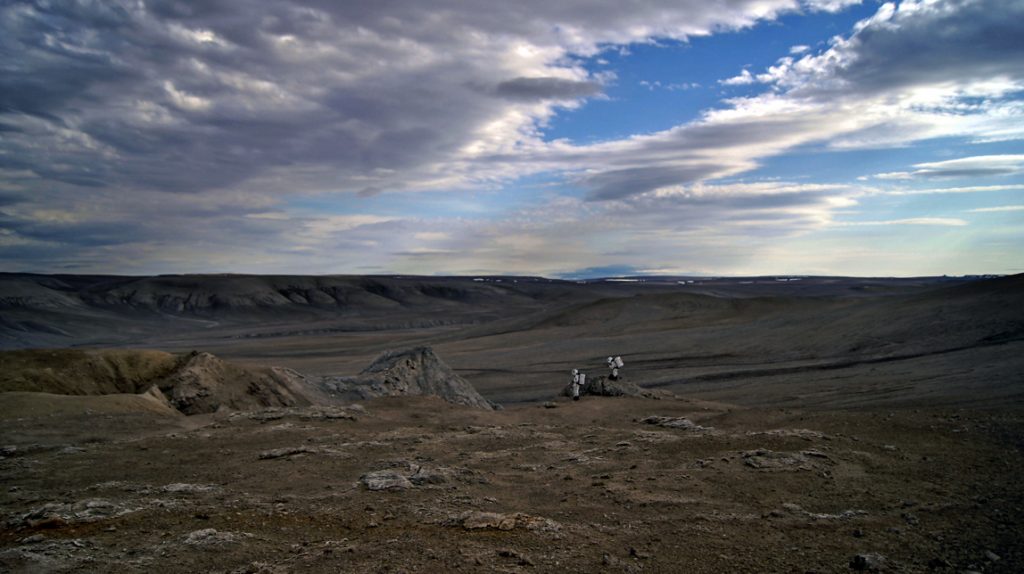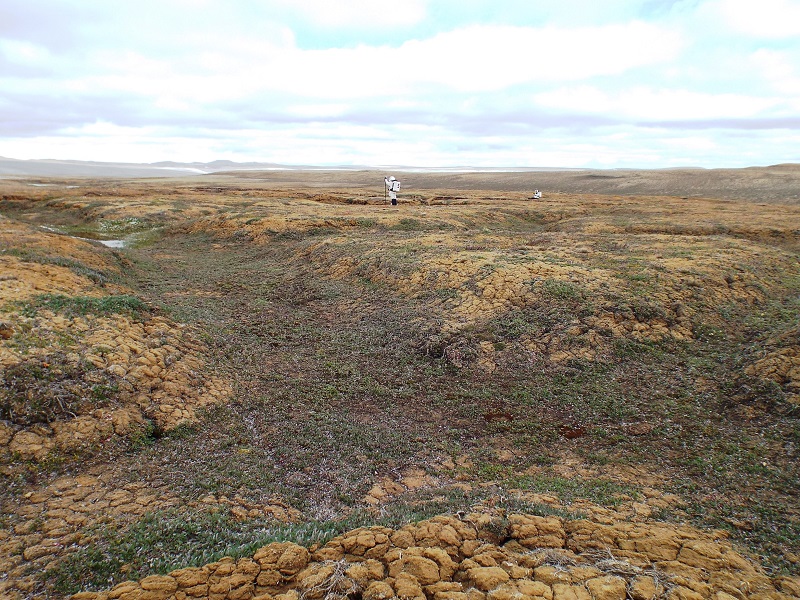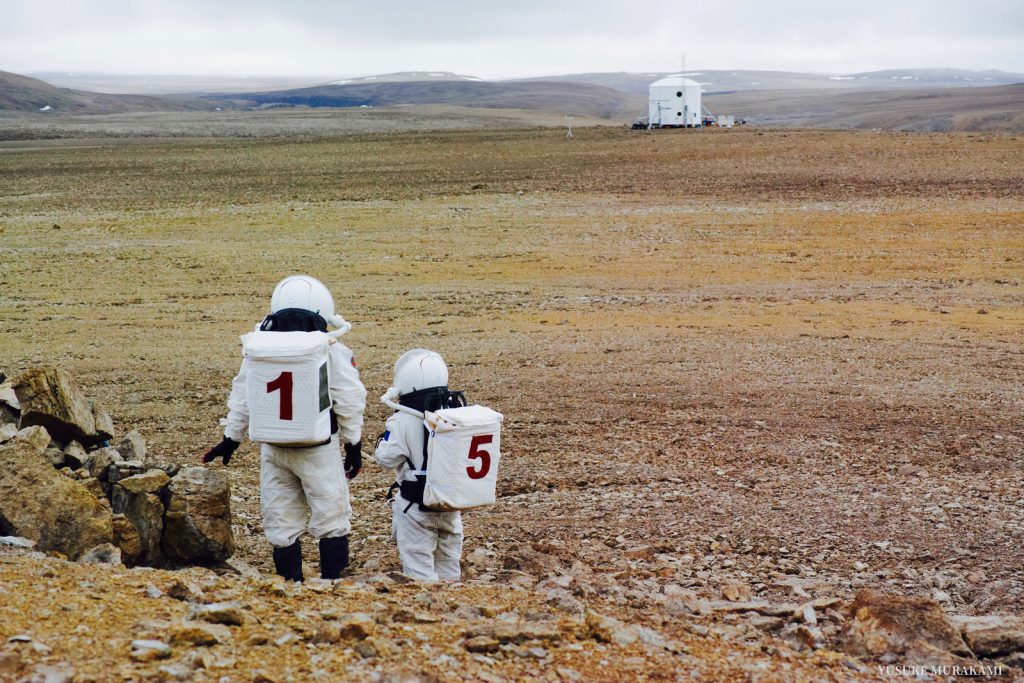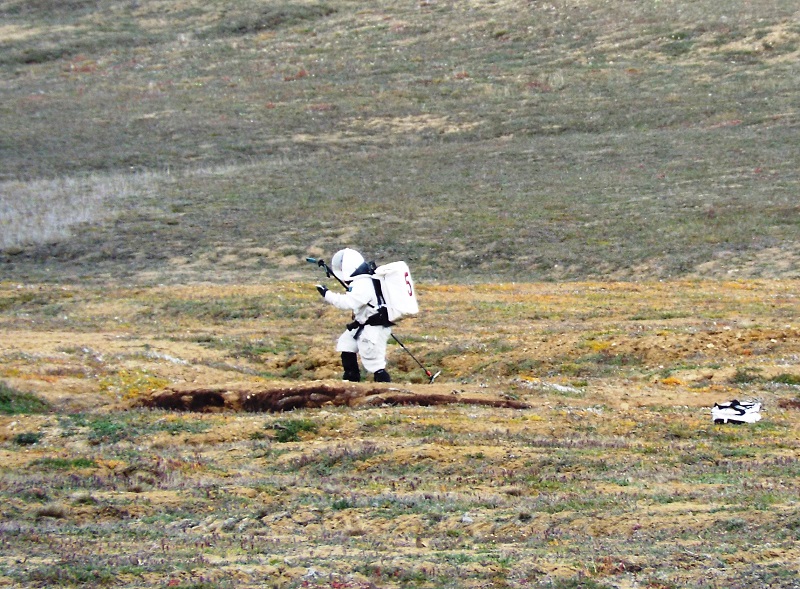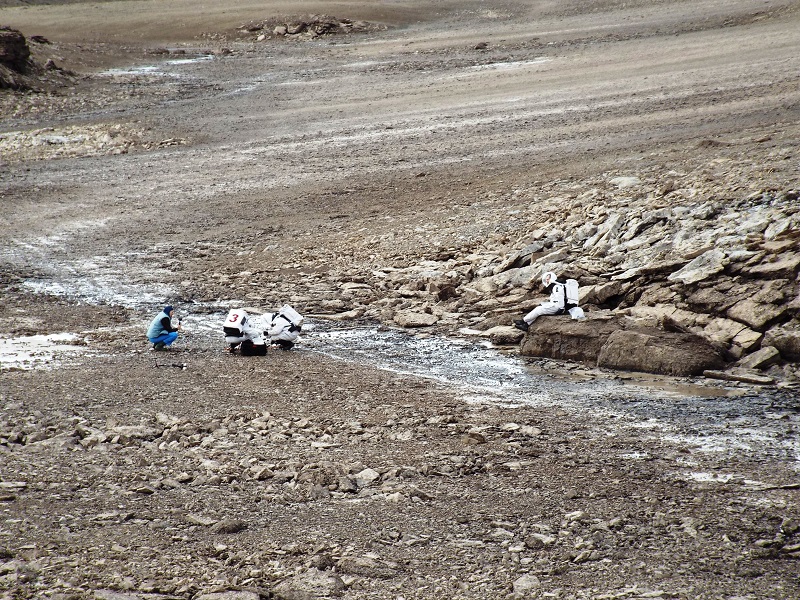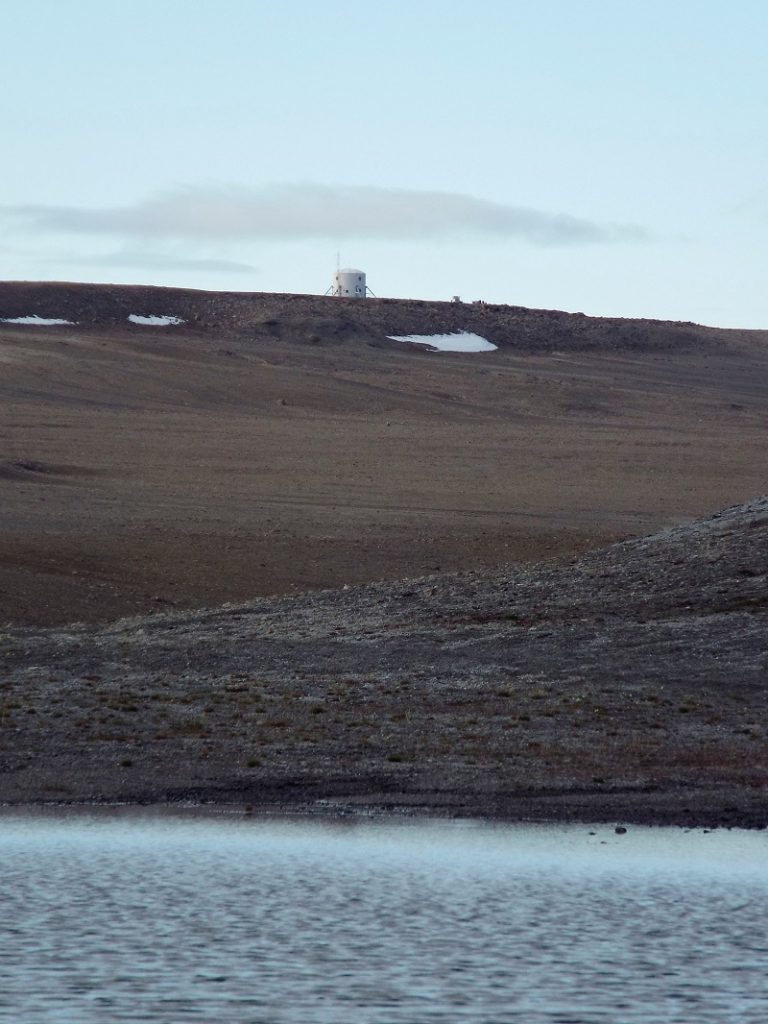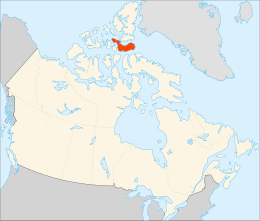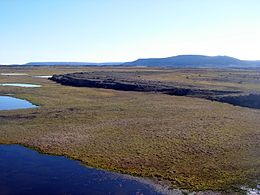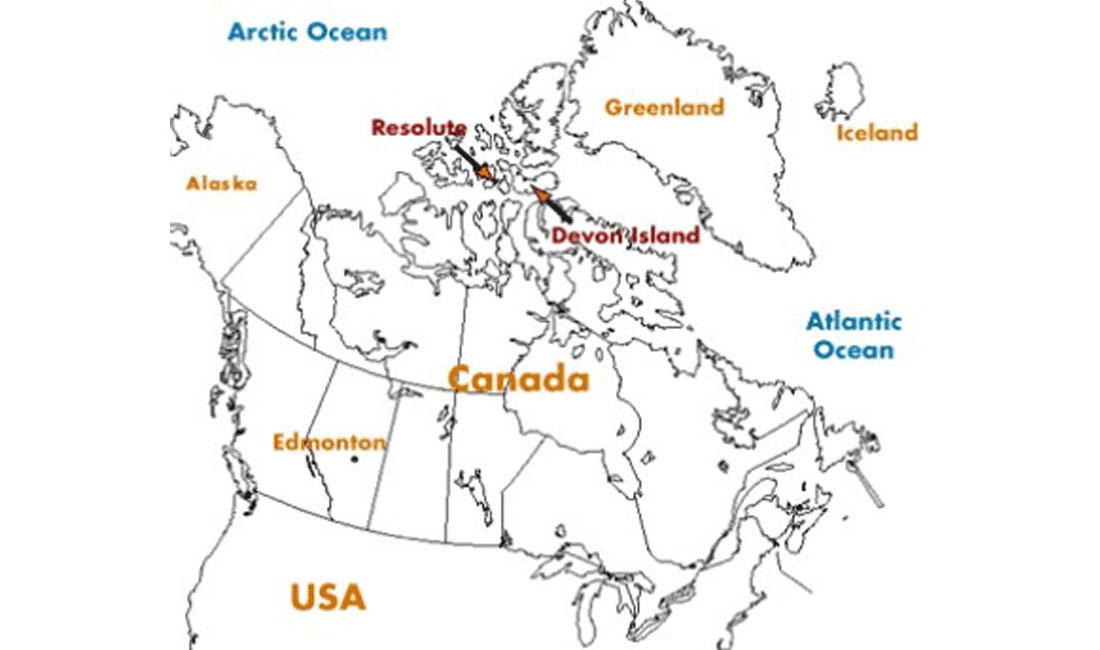New Mars Forums
You are not logged in.
- Topics: Active | Unanswered
Announcement
#1 2019-09-20 08:17:17
- tahanson43206
- Moderator
- Registered: 2018-04-27
- Posts: 23,607
Testing My Hacienda On Mars Society Devon Island
This is primarily for RobertDyck, who is the Creator of this Topic ...
Devon Island is a potential site for a full scale rendering of Sagan City (2018) as envisioned in this topic.
It is more than large enough to hold the 2750 one kilometer square plots, and it is already recognized by NASA (and others) as a close approximation of Mars.
The cost of setting up independent but interconnected Haciendas in that location on Earth would (probably) exceed $100,000,000 each, if all the bells and whistles are included. That is a large price tag, but not out of reach for a significant number of people, institutions and governments.
The undertaking would be in the benign environment of Canada, which would protect it from some of the influences that occur naturally in the human population.
One of the KEY reasons I am interested in this location, and particularly for the sovereignty of Canada, is that it would (presumably) be possible to try out the model of small nuclear reactors to power each of the Haciendas. With sufficient reliable power available, I would expect all the attributes of 2019 first tier culture on Earth to be supportable. As the Earth charges ever more convincingly toward a future in which life on the surface of Earth becomes increasingly risky, this undertaking could be a model for similar developments elsewhere.
The site (were it to be built along the lines envisioned for Sagan City (2018) on Mars) would include tunnels for movement of goods, people and material between Haciendas.
Edit: I haven't looked yet at projections for shoreline decrease at Devon Island in the event of maximum possible sea rise. That would be useful information for planning plot locations.
(th)
Last edited by tahanson43206 (2019-09-20 08:21:13)
Offline
Like button can go here
#2 2019-09-20 20:34:20
- SpaceNut
- Administrator
- From: New Hampshire
- Registered: 2004-07-22
- Posts: 30,014
Re: Testing My Hacienda On Mars Society Devon Island
My last post went into the space of void on the last submittal....
I think that from past discusions that they can not mine or build from insitu materials last I knew. There may be information in some of the topics if they have not crashed in this folder which I have placed this topic within. It is a good question as to can other do simualr work to see what can be done by not bringing the habitats and seeing what could be done via insitu use.
https://www.mnn.com/lifestyle/eco-touri … von-island
It is one of the Canada's Nunavut Territory, the largest uninhabited island on the planet with a landscape so cold, rocky and isolated that scientists have spent two decades there pretending it's Mars.
https://www.mnn.com/earth-matters/space … s-on-earth

Offline
Like button can go here
#3 2019-09-20 21:06:16
- SpaceNut
- Administrator
- From: New Hampshire
- Registered: 2004-07-22
- Posts: 30,014
Re: Testing My Hacienda On Mars Society Devon Island
https://www.climate-policy-watcher.org/ … sland.html
Devon Island (75° N, 86° W) is a large (c.55,000 km2 or 21,200 sq mi), irregularly shaped island forming part of the Parry Island Group within the Queen. Elizabeth Island Archipelago, Nunavut, Canada. First observed among Europeans by William Baffin in 1616, the extent of the island was only fully mapped within the last 200 years
https://www.mnn.com/earth-matters/wilde … ou-may-get

It is a barren 21,000-plus square miles of rock and ice that is so unsuitable for living that the indigenous people of the island, the Inuit, left there for good in the 1930s.

2 floors and its a diameter of 8 meters
Offline
Like button can go here
#4 2019-09-20 21:57:32
- SpaceNut
- Administrator
- From: New Hampshire
- Registered: 2004-07-22
- Posts: 30,014
Re: Testing My Hacienda On Mars Society Devon Island
mining if possible filtering types include elements for rock type list out updating Carbon, Calcium, Iron, Hydro, Potasium, Oxygen, Sulfur, Silicon
https://www.mindat.org/loc-301530.html
Anhydrite, 'Bitumen', Calcite, Copiapite, Ferrihydrite, Fibroferrite, 'Glass', Goethite, Gypsum, Jarosite, Lepidocrocite, Marcasite, Melanterite, Pyrite, Quartz, Rozenite, Szomolnokite
Exploration History and Mineral Potential of the Central Arctic Zn-Pb District, Nunavut
http://pubs.aina.ucalgary.ca/arctic/Arctic59-4-415.pdf
https://en.wikipedia.org/wiki/List_of_c … in_Nunavut
https://en.wikipedia.org/wiki/Devon_Island
The notable similarity of its surface to that of Mars has attracted interest from scientists. Devon Island is also notable for the presence of the Haughton impact crater, created some 39 million years ago when a meteorite about 2 km (1.2 mi) in diameter crashed into what were then forests. The impact left a crater about 23 km (14 mi) in diameter, which was a lake for several million years.
History of activity
https://en.wikipedia.org/wiki/Flashline … ch_Station
Offline
Like button can go here
#5 2019-09-20 22:10:10
- SpaceNut
- Administrator
- From: New Hampshire
- Registered: 2004-07-22
- Posts: 30,014
Re: Testing My Hacienda On Mars Society Devon Island
https://www.canadiangeographic.ca/sites … tic-44.pdf
Camera pixel smoothing simular to mars orbiters
https://en.wikipedia.org/wiki/Haughton% … rs_Project
So if this is an analog for the topic we are at the we have dug in like a tick state of a toehold and would be waiting for the next big step.
It seems that power is fuel based for the generators which shut down for part of the day to conserve on costs to operate.
The other life support materials are as well trucked in for the crews simulation.
So much like mars we could do water from the soil once power levels are simular to what we would see on mars.
Offline
Like button can go here
#6 2019-09-20 22:54:33
- SpaceNut
- Administrator
- From: New Hampshire
- Registered: 2004-07-22
- Posts: 30,014
Re: Testing My Hacienda On Mars Society Devon Island
More of the history
http://home.marssociety.org/arctic/devon.html
Project offers, in our view, a unique potential for broad-ranging science return and an opportunity for innovative engineering in geographic and planetary exploration. It is perhaps the combination of these factors that best defines the significance of the project.
This shows me that trade marking or brand sponsors will help but its not enough for mars
Offline
Like button can go here
#7 2019-09-21 07:23:56
- tahanson43206
- Moderator
- Registered: 2018-04-27
- Posts: 23,607
Re: Testing My Hacienda On Mars Society Devon Island
For SpaceNut multiple posts ...
Thanks for your awesome support of my inquiry!
The point that jumped out at me is that there may exist policies on the part of the Canadian government that would preclude a venture on the scale I am proposing.
On the other hand (speaking to the several Canadians who are members of the forum) it would be a remarkable undertaking to set aside a part of the Island for an insitu settlement attempt on this scale.
Back on the first hand, such a policy adjustment is not impossible, but no doubt it would be difficult.
All sorts of rules about avoiding/preventing contamination would be normal and expected, and those too would be a useful analog for Mars, since the voices of those wanting to keep contamination of Mars to a minimum are strong and likely to grow even more so.
Should the Canadian (people in the end) decide to take this on, they would be overseers and monitors of by far the largest Mars Analog effort ever tried.
Edit: In one of your posts above, I picked up on the Inuits having lived on Devon Island as late as the 1930's. That's pretty remarkable, and a testament to their resilience then (and now). So I'd like to offer an amendment to my proposal for a trial version of Sagan City (2018) on the island: Let this be seen as an Intuit village, designed to handle life on Mars, and at the same time, demonstrating self sufficiency of a village on Earth, with only monthly shipments of items that might be ordered from Earth suppliers. Thus, each plot would be under the supervision of an Intuit citizen, while occupants would be accepted from around the world, to achieve the funding levels needed.
(th)
Last edited by tahanson43206 (2019-09-21 09:12:15)
Offline
Like button can go here
#8 2019-09-21 11:42:45
- RobertDyck
- Moderator
- From: Winnipeg, Canada
- Registered: 2002-08-20
- Posts: 8,322
- Website
Re: Testing My Hacienda On Mars Society Devon Island
Edit: I haven't looked yet at projections for shoreline decrease at Devon Island in the event of maximum possible sea rise. That would be useful information for planning plot locations.
Shores of the Northwest Territories around the Beaufort Sea are eroding rapidly. Permafrost is melting. Much of the land there is silt mixed with ice, as the ice melts the silt washes into the ocean. This is Pelly island, not Devon island.
CBC: Sinking into the sea - The coastline of the Northwest Territories is eroding faster than scientists can measure it

Devon Island has erosion too, but not nearly as dramatic. It helps when the island is made of solid material, not ice.
Devon Island - A Lesson in Erosion






Figure 2. Digital elevation model (DEM) of Haughton crater showing the disconnected outer rim 23 km across, the central depression 16 km across, and the Haughton River draining to the northeast. Source unknown.
Offline
Like button can go here
#9 2019-09-21 13:02:22
- RobertDyck
- Moderator
- From: Winnipeg, Canada
- Registered: 2002-08-20
- Posts: 8,322
- Website
Re: Testing My Hacienda On Mars Society Devon Island
The federal government of Canada is very interested in asserting sovereignty over its territory. And the territorial government of Nunavut wants to ensure it remains "for the people" who live there. The issue is several other countries have challenged Canadian northern territory. China wants resources, Japan wants the Northwest Passage declared an international waterway, even the US Navy has wanted free access to operate nuclear submarines under the ice in Canadian waters. Greenland is a territory of Denmark, they have tried to claim Canadian territory. And still to this day Russia lands manned expeditions on Canadian northern islands. Canada doesn't have sufficient resources in the Arctic to repel all these Russian intrusions. The Canadian federal government has tried to encourage people to permanently inhabit the Arctic to assert this territory. But the people who live there have an issue with non-native interference. Something could possibly be worked out.
Canada acquired the Arctic islands from UK in 1880. That included waters 20 nautical miles off shore.
The Soviet Union declared sovereignty over a wedge of the Arctic north of their territory in 1927. Canada's response was to do the same. This remains Canada's official northern border but aforementioned counties dispute it. If you don't accept this border, then today Canada does enforce sovereignty 200 nautical miles off shore.
Last edited by RobertDyck (2019-09-21 19:32:41)
Offline
Like button can go here
#10 2019-09-21 15:27:40
- tahanson43206
- Moderator
- Registered: 2018-04-27
- Posts: 23,607
Re: Testing My Hacienda On Mars Society Devon Island
For RobertDyck re #9 ...
The Canadian federal government has tried to encourage people to permanently inhabit the Arctic to assert this territory. But the people who live there have an issue with non-native interference. Something could possibly be worked out.
Here is an additional fillip I'd like to toss into the mix .... in another topic, Louis recently brought up a reminder of the need to select crew for a Mars expedition.
Is it possible natural selection has already identified the Inuit (and other northern peoples) as particularly well suited for life on Mars?
(th)
Offline
Like button can go here
#11 2019-09-21 16:19:31
- RobertDyck
- Moderator
- From: Winnipeg, Canada
- Registered: 2002-08-20
- Posts: 8,322
- Website
Re: Testing My Hacienda On Mars Society Devon Island
I appreciate what you're trying to do. Inuit may not be the best. Sherpas of Tibet may be more adapted, because they breathe lower pressure. Apollo launched with 1 atmosphere whole air, but bled air as it ascended. It operated with 5 psi pure oxygen, but could operate with 3.5 psi under defined conditions. Skylab used 5 psi with 60% O2 / 40% N2. Apollo spacesuits (A7L, and for Apollo 15 and later A7L-B) used 3.7 psi pure oxygen. Earth at sea level has 3.0 psi partial pressure O2, and Boulder Colorado has 2.54 psi partial pressure O2.
Documents show early Apollo designs were to use 3.3 psi pure O2. Rationale was a 10% pressure leak would leave them with 3.0 psi which is the same pp as Earth sea level.
This is important for spacesuit design. Dr Paul Webb developed a prototype suit for Apollo but it wasn't ready in time. His MCP suit was safer, more comfortable, greater range of joint movement, less couterforce to movement. Cooling system was a lot simpler, safer, lighter. His prototype used the same 3.3 psi as early Apollo suit designs. It worked. The issue is suits designed for Shuttle and ISS use 4.3 psi. That's because Shuttle and ISS use 1 atmosphere pressure. Before decompressing in a suit astronauts must prebreathe pure O2 for 17 hours to flush out N2 from their blood. If they don't, they'll get the bends. Reducing suit pressure to Apollo level would require even longer oxygen prebreathe. This creates major problems. An MCP suit can work easily with materials from the late 1960s using 3.3 psi, but researchers still haven't developed a practical MCP suit that works at 4.3 psi. Of course the real solution is use the same atmosphere as Skylab: 5.0 psi @ 60/50 O2/N2. Then you could not only use 3.7 psi like Apollo suits, or 3.3 psi like early Apollo development, you could reduce suit pressure further to 3.0 psi. All this would not require any oxygen prebreathe from Skylab pressure. At 3.0 psi you would have to be careful to keep breathing humidity high. You could do that with a nose/mouth breathing mask like a fighter jet. Low humidity over eyes to prevent the visor from fogging. A head-worn helmet like Gemini solves another problem: it could be a crash helmet like a motorcycle helmet, for safety when driving an ATV. Apollo head-worn helmet solved the issue of moving the neck when a gas bag suit is pressurized, but isn't necessary for an MCP suit.
You could adjust pressure further for Mars. With 3.0 psi suit pressure, habitat could use 2.7 psi partial pressure O2 so astronauts are accustomed to 10% less O2 than suit air. Still more O2 than Boulder CO. Max N2 for zero prebreathe is 1.2 time total suit pressure so max have N2 would be 3.6 psi. Then add argon. Earth atmosphere has 0.93% argon. You could add some argon to increase Hab pressure. To make it easy produces Hab air on Mars, make the ratio of N2:Ar the same as Mars atmospher. Viking 2 lander measured 2.7% N2, 1.6% Ar, so this would give the Hab 2.133 psi partial pressure Ar. There's also a maximum partial pressure of argon for zero prebreathe but this is below that. That would give the Hab a total of 2.7 + 3.6 + 2.133 = 8.433 psi.
But NASA has gotten stuck on the idea that suit pressure *HAS TO BE* 4.3 psi. So MCP development is blocked. Ps, an MCP spacesuit is machine washable.
Last edited by RobertDyck (2019-09-21 16:25:06)
Offline
Like button can go here
#12 2019-09-21 16:40:08
- SpaceNut
- Administrator
- From: New Hampshire
- Registered: 2004-07-22
- Posts: 30,014
Re: Testing My Hacienda On Mars Society Devon Island
Interesting as the land territory is we would want it to be more international for defense of the protected Inuit peoples homelands.
What could be done is establishing more Mars society operations on that northern boundary to discourage this action.
Do you have direct access to the knowledge of the societies agreements for being able to use the island?
Can you post the details if possible?
Offline
Like button can go here
#13 2019-09-21 19:57:21
- SpaceNut
- Administrator
- From: New Hampshire
- Registered: 2004-07-22
- Posts: 30,014
Re: Testing My Hacienda On Mars Society Devon Island
HUMAN FACTORS RESEARCH AS PART OF A MARS 2 EXPLORATION ANALOGUE MISSION ON DEVON ISLAND
http://www2.hawaii.edu/~binsted/papers/ … ctures.pdf
Intra-crater sedimentary deposits at the Haughton impact structure, Devon Island, Canadian High Arctic
https://journals.uair.arizona.edu/index … 5215/15203
Kieth Cowing Nasawatch 10 articles from 2006 on Devon Island work
Islands as refuges for surviving global catastrophes
https://philarchive.org/archive/TURIAR
Offline
Like button can go here
#14 2019-09-21 20:19:01
- RobertDyck
- Moderator
- From: Winnipeg, Canada
- Registered: 2002-08-20
- Posts: 8,322
- Website
Re: Testing My Hacienda On Mars Society Devon Island
This is primarily for RobertDyck, who is the Creator of this Topic ...
Devon Island is a potential site for a full scale rendering of Sagan City (2018) as envisioned in this topic.
The first and most important question is what people would do for a living there. People aren't going to move there unless there's gainful employment. Businessmen aren't going to set anything up unless there's profit. So what will they do there?
Offline
Like button can go here
#15 2019-09-21 21:20:56
- SpaceNut
- Administrator
- From: New Hampshire
- Registered: 2004-07-22
- Posts: 30,014
Re: Testing My Hacienda On Mars Society Devon Island
Food, Water and power are the first collective business to provide...
The "Martian" flora: new collections of vascular plants, lichens, fungi, algae, and cyanobacteria from the Mars Desert Research Station, Utah
https://bdj.pensoft.net/articles.php?id=8176
So we get 6 months to be there while the other we currently leave so we need to store and provide for that much time...so as to be able to stay all the time.
Offline
Like button can go here
#16 2019-09-22 01:43:54
- Terraformer
- Member
- From: The Fortunate Isles
- Registered: 2007-08-27
- Posts: 3,988
- Website
Re: Testing My Hacienda On Mars Society Devon Island
tahanson43206 wrote:This is primarily for RobertDyck, who is the Creator of this Topic ...
Devon Island is a potential site for a full scale rendering of Sagan City (2018) as envisioned in this topic.
The first and most important question is what people would do for a living there. People aren't going to move there unless there's gainful employment. Businessmen aren't going to set anything up unless there's profit. So what will they do there?
That's the whole issue with space colonisation, isn't it?
We could buy it off the Inuit. Give Nunavut a sufficient wealth fund, and maybe they can be enticed to vote for independence, and in turn to grant it to one of the islands.
Use what is abundant and build to last
Offline
Like button can go here
#17 2019-09-22 05:37:07
- louis
- Member
- From: UK
- Registered: 2008-03-24
- Posts: 7,208
Re: Testing My Hacienda On Mars Society Devon Island
There will be absolutely no shortage of "things to do".
There is science. There are about 10,000 Universities on the planet. Many are large and prestigious and have access to billions of dollars of funding. But there is no reason why smaller universities can't form consortia to put science experimetsn on Mars. I foresee a range of science and exploration missions from huge ones backed by Unis like Harvard, Cambridge, Paris and Tokyo which will send personnel and rovers to the planet, down to tiny 5 Kg science instruments measuring various phenomena. There are also maybe 15 space agencies on planet Earth that would be interested in working with Space X on Mars.
There is advertising and marketing. If you were Ford or Toyota wouldn't you want to see video of your (specially adapted) off-road vehicle tackling the terrain of Mars - you can use that in your adverts but even more you can get loads of free publicity all around the world if you package it up as a news item. How much would you pay for that? These automobile companies have billions of dollars in their advertisting budgets.
There is art. Why wouldn't artists on Earth not want to be the first to create Mars-related work and have it exhibited there. The work can be created remotely.
The point about all these various activities is that they will involved people and the people will require transport, accommodation and life support and they will pay someone (presumably Space X) for those services. So Space X will have a ready made business on Mars.
Space X can also directly employ people in creating video for sale back on Earth, photographic art to be used in lavish coffee table books and sold to the media, travel writing, scientific books and so on. The global book market is worth $143 billion. Space X should be able to cream off at hundreds of millions of dollars from that market. Space X can also collect regolith and meteorites for sale back on Earth. There may even be very pure gold at the surface that can be mined simply, with a power drill.
The above are just the beginnings. There are so many possiblities which we can't really see yet.
tahanson43206 wrote:This is primarily for RobertDyck, who is the Creator of this Topic ...
Devon Island is a potential site for a full scale rendering of Sagan City (2018) as envisioned in this topic.
The first and most important question is what people would do for a living there. People aren't going to move there unless there's gainful employment. Businessmen aren't going to set anything up unless there's profit. So what will they do there?
Let's Go to Mars...Google on: Fast Track to Mars blogspot.com
Offline
Like button can go here
#18 2019-09-22 05:43:03
- tahanson43206
- Moderator
- Registered: 2018-04-27
- Posts: 23,607
Re: Testing My Hacienda On Mars Society Devon Island
For RobertDyck, Terraformer, SpaceNut and all who have supported My Hacienda to this point ...
Thank you!
It is remarkable that after 500 years (dating from the Magellan expedition) we see in full force the European leaning toward ownership of property which has transformed the world (for better and worse). In the insight that Intuit (and similar Northern peoples) there may exist a capability to settle Mars not as readily available to others, we open the ancient difference in perception of the land and its relationship to humans.
To the question of employment posed by RobertDyck, I think the answer is readily drawn from the premise, that wealthy entities will be willing to invest on the order of $100,000,000 (US) to establish one plot of 2750. That investment will drive innovation at a high rate, and there will be plenty of employment opportunities for humans.
Like the South Pole research facilities, the reward for investors is the scientific papers that will flow from an experiment on this scale.
As just one example of many, the tunnel boring equipment needed to create the underground network of passages for transport of goods, people and materials will be more advanced than any in existence on Earth today. I say that not to criticize what is very advanced capability already, as shown in Europe, Asia and the US (and surely many more I'm not aware of), but by the competitive environment this undertaking will create.
The problem of finding ways to process waste for a population of the size likely to assemble in this endeavor has been partially solved already, but this project will require solutions that will then serve as models for the rest of the population of Earth.
The problem of growing fresh food for the population without importing anything has NOT been solved, but it must be solved for Mars, and the premise of the experiment is that it can be solved, and that it ** will ** be solved.
(th)
Offline
Like button can go here
#19 2019-09-22 09:21:00
- SpaceNut
- Administrator
- From: New Hampshire
- Registered: 2004-07-22
- Posts: 30,014
Re: Testing My Hacienda On Mars Society Devon Island
One could use the thick coregated plastic pipes to act as the tunnels of mars with soils from the surface heaped about it as if its the first of such we are constructing on mars long before boring equipment is on mars.
The size of additional tunnels can also be used for seperate access to distances without a space suit even if its pretend.
We are in the Toehold stage (Plot 0003) of the first mission to mars still trying to setup for the future that we would desire at the analog site.
Maybe the UN should step in on behalf of the inuit peoples to lay down agreements for the use of the lands now exposed from the receding ice such that the land grabs end. Set it up to the frame work of Antartica so that all nations can participate away from there settlements. Just maybe some of the same participants for Antartica would be willing to do the same for the other end of the world of the north.
Mars like the analog site; needs to be focused on the isolation from supply and self sufficiency which we need in the planning for follow up missions. I look at this as a means to move towards that seperation and staying power that any trip to mars would require.
Sure the mars year would be only half as long but so what when you look at how do you survive its just 2 x every thing for each season anyways for the 1x crew size for a mars cycle. Look at this as a next level biosphere test.
Remember the landings are at a fixed rate but the goals for each keep moving towards a city of 1000's eventually.
Offline
Like button can go here
#20 2019-09-22 09:45:10
- RobertDyck
- Moderator
- From: Winnipeg, Canada
- Registered: 2002-08-20
- Posts: 8,322
- Website
Re: Testing My Hacienda On Mars Society Devon Island
This discussion is about building an analogue community on Devon Island. Mars has a few advantages, one is there is no government on Mars. I wrote a proposal for corporate government on Mars. No tax what so ever, and minimal laws. Groups or corporations could build towns or cities. The national laws on Mars would prevent murder and theft/robbery, and towns would not be allowed to posses a military or weapons of war, but could posses a police force. So one draw is just to get away from government. But this discussion is about a community on Devon Island.
Devon Island is actually quite large. It's 54,100 square kilometres. This isn't some tiny thing like Hans Island. Hans Island is between Ellesmere Island and Greenland, ownership disputed between Canada and Denmark. Hans Island is only 1.3 square kilometres, half a square mile. But Devon Island is larger than several US states! Devon Island has more land area than Maryland, Hawaii, Massachusetts, Vermont, New Hampshire, New Jersey, Connecticut, Delaware, Rhode Island, or the US territory of Puerto Rico. It's big, but what would we do there?
It's part of Canada, so Canadian federal laws apply, Canadian taxes including both income tax and the GST (Goods and Services Tax, a federal sales tax, basically the same as the UK's VAT). The territory of Nunavut has a 2% payroll tax, paid by employers. Nunavut brags that their provincial income tax rate is the lowest of any province or territory in Canada, but there is one. There's no provincial/territory sales tax. In provinces, property tax is charged by cities/towns/municipalities, not provincial governments; but in Nunavut property tax is administered by the territory. Like all provinces, Nunavut has a petroleum tax, incorporated into the price of gasoline at the pump. The territory has tobacco tax, but no alcohol tax. And the current federal government is forcing all provinces to impose a carbon tax, any who refuse will have a federal carbon tax imposed. Nunavut is subject to the federal carbon tax. So Devon Island is not a tax haven.
Some communities in Nunavut have banned alcohol, but obviously not Devon Island since it's not populated. But Nunavut requires a license to import more than 3 litres of spirits, 9 litres of wine, or 26 litres of beer. That's "import", doesn't say anything about home beer/wine making, and Canadian federal laws do permit home distilling on the strict condition that it's for personal consumption. Provincial laws where I live in Manitoba also permit home distilling, don't see anything different in Nunavut.
You argue this would be a good research project. But you aren't talking about building a habitat like FMARS that's empty 10 months per year. You want a community with people permanently living there. What's the draw? Research isn't enough. I've argued Mars has the attraction of no government, no regulation, no tax, but Devon Island is in Canada so has all of Canada's laws/regulations/tax.
My girlfriend suggested this could be a place to test my method to convert rock into arable soil. But Devon Island is above the arctic circle. Truelove Lowland has been called a polar oasis, the southern end of the island. Temperatures in summer are usually between 2°C and 6°C. That's summer! It's inside the arctic circle, Sun doesn't rise at all November 5 though February 5 (93 days). (NOAA Sunrise/Sunset calculator)
Wikipedia: Devon Island
Because of its relatively high elevation and its extreme northern latitude, it supports only a meagre population of muskox and small birds and mammals; the island does support hypolith communities. Animal life is concentrated in the Truelove Lowland area of the island, which has a favourable microclimate and supports relatively lush Arctic vegetation. Temperatures during the brief (40 to 55 days) growing season seldom exceed 10°C (50°F), and in winter can plunge to as low as −50°C (−58°F). With a polar desert ecology, Devon Island receives very little precipitation.
Cape Liddon is an Important Bird Area (IBA) notable for its black guillemot and northern fulmar populations. Cape Vera, another IBA site, is also noted for its northern fulmar population.
Devon Island is also notable for the presence of the Haughton impact crater, created some 39 million years ago when a meteorite about 2 km (1.2 mi) in diameter crashed into what were then forests. The impact left a crater about 23 km (14 mi) in diameter, which was a lake for several million years.
I would prefer to do my soil experiment at Saint Theresa Point. There's a cluster of First Nations there, the largest is Saint Theresa Point. It's east of the northern end of Lake Winnipeg, but there's still forest. Wheat farms in Saskatchewan operate at the same latitude, the issue is Saint Theresa Point is boreal forest on Canadian shield, there's very thin soil. Cut solid bedrock, grind to rock flour, and grow a peat bog to produce acid to convert rock flour to soil. My method would use solar powered pumps to circulate water in the peat bog, with a slow sand filter deep under the rock flour to ensure pump inlet doesn't get clogged. This method should produce arable soil 2 metres deep (enough for wheat), in a decade or two. I would like to do this with an area 10 miles by 10 miles, so 100 "sections" of land. The community there could grow enough food to support themselves, and even export food. I came up with the idea to produce soil on Mars after warming the planet to produce sufficient CO2 atmosphere to allow humans to walk outside with just an oxygen mask, no spacesuit, and warm enough for rain. But it can be done now for northern indigenous communities.
Last edited by RobertDyck (2019-09-22 11:04:49)
Offline
Like button can go here
#21 2019-09-22 11:41:44
- RobertDyck
- Moderator
- From: Winnipeg, Canada
- Registered: 2002-08-20
- Posts: 8,322
- Website
Re: Testing My Hacienda On Mars Society Devon Island
Do you have direct access to the knowledge of the societies agreements for being able to use the island?
Can you post the details if possible?
Tried to look it up. I can say Pascal Lee of NASA operated the Haughton Mars Project (HMP) of NASA, and invited the Mars Society to build an analogue research station at his facility. This provided more money than NASA alone provided. Pascal Lee and NASA set up the original agreements, so the Mars Society could focus on building the Mars Arctic Research Station (M.A.R.S.) which was later named Flashline Mars Arctic Research Station (FMARS) after receiving sponsorship money from that company. Unfortunately Dr Zubrin and Dr Lee had a disagreement, they literally moved their stuff to opposite sides of the crater. The Mars Society had to deal with Nunavut territory directly after that. I don't know any of those details.
I do know expeditions take a commercial airline flight to the airport at Resolute Bay. During the Cold War the Canadian Military build an air force station at Resolute Bay. It was a station, not a base, which meant aircraft were not permanently based there, but could operate out of there. That station was decommissioned, the air force station became the commercial airport for the nearby town (hamlet) of Resolute. Today Mars Society expeditions charter a Twin Otter aircraft from Resolute to Devon Island.
Also, there's a Canadian federal air safety regulation that any aircraft with only a single engine is restricted when flying over open water to only as far as gliding distance back to shore. This became an issue when a Mars Society member living in Baker's Lake, Nunavut, wanted to volunteer the services of his Maule aircraft with tundra tires to carry personnel to FMARS on Devon Island. But that aircraft has a single engine, and Perry Channel is wider than gliding distance, so a Maule is not allowed to fly during summer. It would be allowed in winter when the channel is frozen and the ice is thick enough to land the aircraft, but the Mars Society only operates FMARS in summer. So unfortunately the Society couldn't accept this individual's offer.
Offline
Like button can go here
#22 2019-09-22 14:35:51
- SpaceNut
- Administrator
- From: New Hampshire
- Registered: 2004-07-22
- Posts: 30,014
Re: Testing My Hacienda On Mars Society Devon Island
https://en.wikipedia.org/wiki/Haughton-Mars_Project
With that information a supply train in winter could be had though to get the site ready for the following season by bringing the cargo to the site...This would allow for more science gear during the summer season when staff is there. Will see what I can dig up for the contracts with that bit of information. I am sure its there some where.
https://en.wikipedia.org/wiki/Pascal_Lee
Offline
Like button can go here
#23 2019-09-22 15:16:26
- tahanson43206
- Moderator
- Registered: 2018-04-27
- Posts: 23,607
Re: Testing My Hacienda On Mars Society Devon Island
For RobertDyck and SpaceNut (and all who are helping this topic along)...
Thanks for the images and text which carry this little idea along a bit further.
Something that might be worth adding as a motivation is the high level engineering that will be required, and thus the potential opportunities for patents and new customer orders for individuals, institutions and firms which participate.
On top of that, the agricultural challenges, of building underground growing fresh crops to feed several thousand people have not been overcome on this scale, so that too should be of interest to (again) individuals, institutions, firms and even nations.
There may be other practical applications of work done in support of this venture that I am not aware of, but hopefully others can add to the list.
(th)
Offline
Like button can go here
#24 2019-09-22 15:22:12
- Terraformer
- Member
- From: The Fortunate Isles
- Registered: 2007-08-27
- Posts: 3,988
- Website
Re: Testing My Hacienda On Mars Society Devon Island
Would an Alaskan location be better from a governance perspective? How does Alaska compare against Nunavut, and their respective federal governments against each other? There are 10x as many US citizens as Canadian ones, so it's a far bigger pool to draw from. How would the Alaskan Arctic Free Cities fare?
There's also the Svalbard Islands. It's a free economic zone with access for all treaty nations, and there is already a market there for locally produced goods and services.
Use what is abundant and build to last
Offline
Like button can go here
#25 2019-09-22 16:12:32
- SpaceNut
- Administrator
- From: New Hampshire
- Registered: 2004-07-22
- Posts: 30,014
Re: Testing My Hacienda On Mars Society Devon Island
We might not be able to tunnel but we can trench and bury a tube that is made in a way to allow for the concept of isolated from natural light and to be able to pretend an airlock is featured for entry if not connected to the pipe line system we proposed in Voids topic Plot 0012 in the original business for mars.
The moxie would be a good test article to make for the habitat to fuel concepts with regolith practice for the water via solar concentrated heat with in a chamber methods.
Offline
Like button can go here

